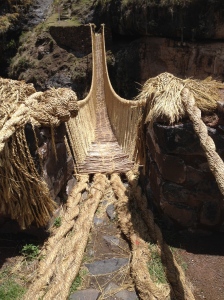The Inca empire had a road system known as the Qhapaq Nan. It spread from Colombia in the north to Chile in the south 20,000 miles. The rope bridges were built to cross deep canons and rivers and were used by herdsmen, troops, and Chaski messengers. In case of war they could be cut. They united communities and symbolized rituals of passage.
Q’eswachaka is about 100 kilometres from Cusco city. The bridge crosses the *Apurimac River Canyon. (God who talks) This is the last Inca bridge in the Andes and it is reconstructed every year. Nearly 700 men and women from the communities of Quehue, Huinchiri and Q’ollana come to build Q’eswachaka. Women gather long blades of Ichu grass which are then woven by men into six long cables (Toros) used in the construction of the bridge. The wide ropes are bound at either end of the bridge. Two Chakiro (master bridge makers) weave the rails and floor. They start at each side of the mountain and meet near the center. In 2013, Qeswachaka the UNESCO recognized it as an Intangible Heritage of Humanity.



